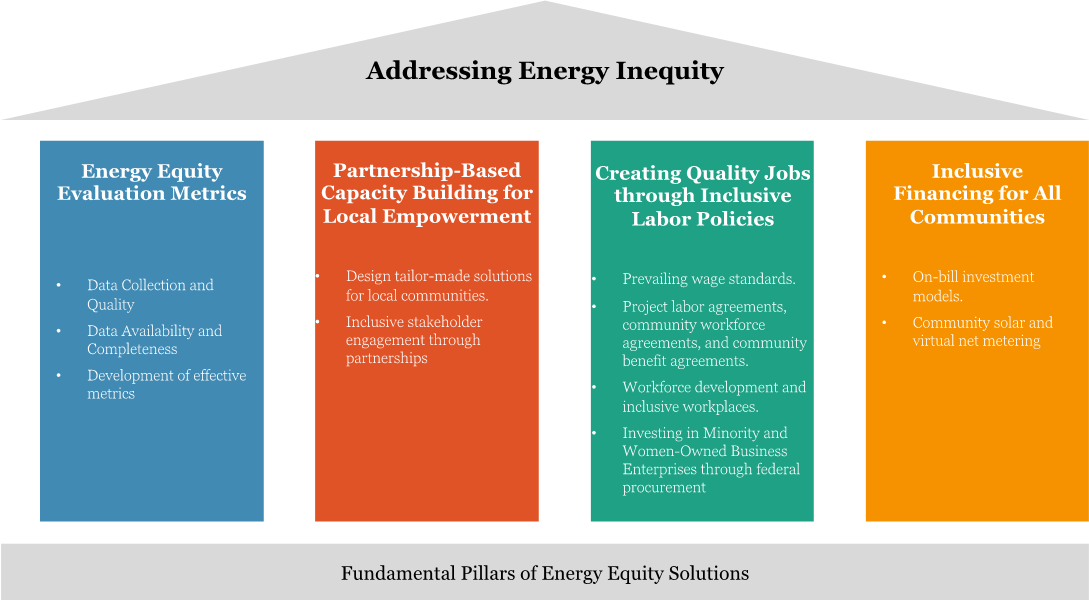The United States, in general, and New Jersey specifically, are undergoing significant changes in energy production, with a focus on transitioning away from carbon-intensive sources and towards clean energy. In an earlier blog article, “Energy Inequity in New Jersey,” we learned that low-income and minority communities are disproportionately affected by energy inequity. The state policy on clean energy will be instrumental in supporting and protecting these workers and communities that are disproportionately impacted by these changes, particularly low-income, rural, and minority populations.
Ensuring that all segments of society benefit from the shift to clean energy is crucial, and policymakers must incorporate this aspect into the design, implementation, and evaluation of energy policies. The transition to clean energy often involves using public resources and can be a slow process that impacts society. Therefore, it is essential to assess the distribution of costs and benefits of various energy policies. In New Jersey, there are three main aspects of energy inequity: environmental injustice, high energy burden on vulnerable populations, and unfairness in clean energy policies. These issues are often fueled by the inequitable sociopolitical context in which the energy system operates, which includes structural and systematic marginalization and ongoing and historical discrimination against vulnerable communities who face the greatest hardship (Carley & Konisky, 2020)[1]. By addressing these issues, New Jersey has the potential to be a model for the effective implementation of energy equity policies across the nation and the globe.
How do we address the issue of Energy Inequity?
Policy recommendations for issues of equity are always complicated, especially in a culturally and ethnically diverse society like New Jersey. This diversity leads to a scenario in which there is no one-size-fits-all solution (Cervas & Giancatarino, 2017)[3]. The energy transition to more sustainable sources will require various policy measures to support and address the needs of different communities that are impacted by the shift away from fossil fuels. These communities can vary significantly in their characteristics, including demographics, geography, politics, and more. To effectively support these communities during the transition, it will be necessary to tailor policies to the specific needs and circumstances of each community. Thus, taking a bottom-up approach to equity policies is critical. However, even before deciding on policy recommendations, it is essential for us to identify the communities that are most affected. This can be done by focusing on addressing issues of data quality, data availability, and the development of evaluation metrics (Carlock et al., 2021)[2].
Once these communities are identified, to address energy inequity in the state of New Jersey, it is recommended to review and improve existing state programs that target this issue through targeted investment. Gathering feedback from impacted communities and assessing data on program outcomes can help to identify areas for improvement. In addition, implementing effective and data-driven programming on energy equity informed by the experiences and needs of target households and communities can help ensure these initiatives are effective. Disadvantaged communities in the state should be empowered to access clean energy initiatives and apply for state funding, which could involve providing training and resources and removing barriers to participation. It is also essential to bring the interests of historically excluded communities to the forefront of clean energy spending in the state and empower these communities to take a lead in program design, implementation, and monitoring. Ensuring that clean energy spending creates pathways to good jobs for a diverse workforce and supports inclusive financing approaches in disadvantaged communities can also help to address energy inequity in the state. The recommendations mentioned above can be categorized into four major categories: energy equity evaluation metrics, local capacity building using engagement and partnership approaches, effective labor policies to create quality jobs in all types of communities, and inclusive financing such that governments can make targeted investments for all communities (Carlock et al., 2021)[2]. In future articles, we will delve deeper into each of these categories to fully comprehend the policy recommendations related to addressing energy inequity and promoting clean energy adoption. Through this in-depth analysis, we can gain a better understanding of these recommendations and how they may be effectively implemented.

Tarun Reddy Arasu is a graduate student pursuing a Master of Public Policy degree at the Edward J. Bloustein School at Rutgers University.
References
- Carley, S., & Konisky, D. M. (2020). The justice and equity implications of the clean energy transition. Nature Energy, 5(8), 569–577. https://doi.org/10.1038/s41560-020-0641-6
- Carlock, G., Neuberger, J., Calle, L., & Said, E. (n.d.). ADDRESSING ENERGY EQUITY IN THE UNITED STATES: https://files.wri.org/d8/s3fs-public/2021-11/energy-equity-united-states.pdf?VersionId=dIWzPo.M0qXoKLDixuPAohcv70.kcTYJ
- Cervas, S., & Giancatarino, A. (2017). Energy Democracy Through Local Energy Equity. In D. Fairchild & A. Weinrub (Eds.), Energy Democracy (pp. 57–75). Island Press/Center for Resource Economics. https://doi.org/10.5822/978-1-61091-852-7_4
- Jenkins, K., McCauley, D., Heffron, R., Stephan, H., & Rehner, R. (2016). Energy justice: A conceptual review. Energy Research & Social Science, pp. 11, 174–182. https://doi.org/10.1016/j.erss.2015.10.004
- Nathan, S. S., Chintam, K., Clingman, B., & Johnson, A. (2021). Best Practices for an Equitable Clean Energy Transition: A Toolkit for U.S. States. Journal of Science Policy & Governance, 18(02). https://doi.org/10.38126/JSPG180208
